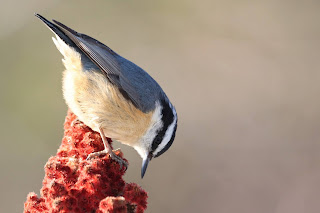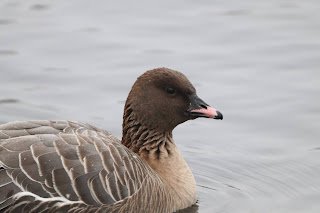 |
| Redwing, Capisic Pond Park, Portland, ME |
As I have mentioned before and probably will again, I bird every single day off from work, weather dependent. Almost all of that birding is in Rhode Island. I would not use the word monotonous, but when you bird the same places over and over year after year, mundane is the rule not the exception. When there is an opportunity to do something different and go on an adventure, it does not take much to persuade me.
A month back a Redwing was spotted in a small park in Portland, ME. The name of the park is Capisic Pond Park. Redwing's are a Eurasian species. They like open farmland, open woods, and fields. They are common as far west as Iceland. They do stray to the Canadian Maratimes once in a while but are far more rare in the US. There have only been a few sightings in the Lower 48. I could not get an exact count, but the number of sightings in the states is probably just over five. So it is rare!
When it was found (I believe on a Thursday) many Rhode Island birders drove up to Maine the following Saturday. They all took separate cars and met at the lot. I could not go because I had to work. My friend Sue could not go because she had to babysit her grandchildren. It was during that cold snap where the high temp was eight degrees and the wind was blowing about 20 mph. Needless to say, I am glad I did not have the chance to make a decision to go or not. They found the bird and got great looks at it, but it was so cold, they were back in their cars in a little over an hour.
Two weeks ago, Sue suggested we go up on Saturday February 20. I was willing, so we made plans to go. Neither of us had any desire to drive alone so we each got a Covid test so we could carpool. Once we got our negative results we were rearing to go. Besides the Redwing, there are two other interesting species at the park, a pair of Dickcissel has been there all winter and so has a Black Headed Grosbeak. So even if we dipped on the Redwing, chances were good the trip wouldn't be entirely in vain. Sue lives in Westerly and I live in North Attleboro, so she picked me up. We left North Attleboro at 7:15 am.
 |
| Dickcissel |
We made it to Capisic Park before 10 am. We got out of the car and walked down the trail. When we turned a corner right in front of us about fifty yards were birders with their binoculars up all facing a bush. Needless to say we had a good idea of what they were looking at. Sure enough, when we walked up there the Redwing was feeding on berries. We watched it and photographed it for about fifteen minutes before it got full and flew across the pond.
Fifteen yards down from where we saw the Redwing I saw a flock of House Sparrows. Knowing Dickcissel will associate with House Sparrows I waited and watched. Within two minutes a Dickcissel came out of the undergrowth and posed in the bushes. Again, we watched and took pictures before it flew into some more bushes across the path. Thirty minutes in and we were two for two!. We spent the next ninety minutes looking for the Black Headed Grosbeak. It hadn't been seen for a couple of days but we still looked hard for it. We never found it but did come across the Dickcissel again even more out in the open.
 |
| There are benches dedicated to people around park. The Redwing is near the Henry Bench. Sue was quite pleased to see a bench dedicated to a Susan. |
At this point it was still before noon. The Redwing hadn't been seen again which was disappointing some long distance travelers hoping to see it. So we decided to go birding elsewhere.(* the Redwing was spotted again later in the afternoon) Driving back down I-95 in Maine we saw a bunch of hawks and we were so happy to see a highway Raven we did an ebird report.
Once we got to New Hampshire we went down the coast. Sue was hoping to get some New Hampshire State birds. Our longest stop was at Hampton Beach. We got Common Eider, Loon, and Horned Grebe in the river that runs along the beach. Our best birds were an Ipswich Savannah Sparrow along the dunes, and about a dozen Purple Sandpipers along a rocky outcrop a few yards from shore.
After (hopefully) finding the Redwing, the plan was to bird the NH coast on the way to Salisbury Beach. Salisbury Beach has had a lot of very good species there this winter. There have been Red Crossbills, Snow Buntings, Common Redpolls, and Red Breasted Nuthatch in the campground all winter. There are at least two White Wing Crossbills flying around. The marsh has had a Snowy Owl and Short Eared Owl the last couple of weeks also! Lastly, in some pine trees near the parking lot a Long Eared Owl has been sleeping away the days for a couple of weeks. So in short, there were plenty of reasons to go to Salisbury Beach.
I had actually been to Salisbury Beach twice in the last month. I had seen all of the above birds mentioned except the Long Eared and Short Eared Owl. I wasn't worried about the Short Eared Owl. It only starts flying at dusk and I have seen them in MA and RI multiple times. I did see the White Winged Crossbill my previous trip. I didn't get a photo because I was pointing it out to my friend Laurie when it flew. I really wanted to get a photo if Sue and I had time. However, the real prize for me would be the Long Eared Owl. It would be a lifer. The previous times I went to Salisbury I scanned the pines multiple times throughout the day but never saw it.
 |
| Photo of Long Eared Owl blown up at least 800 % |
When Sue and I got there, our first stop were the pines the owl lives in. There are cones set up around the parking lot to keep people from bothering the owl. The cones are a very respectful distance away. Luckily for us, the Long Eared was out!!! It wasn't "out in the open" but it was within view. There was about an eighteen inch opening in the brush where you could see it from behind the cone line. Step two feet to the right or left of that eighteen inch box and the owl was not in view. Needless to say, from that distance and that small of a window my photos are awful. However, I was thrilled to see it. Two lifers in one day, and this was the one I've been trying to see for a couple of years. It meant a lot.
The Long Eared Owl was a lifer for me but not for Sue. In our binoculars it really wasn't much more than a reddish/tan spot in a pine. Sue got her scope out and we got a great look with that. She was kind enough to let others look through her scope providing they didn't touch it with their eye. At least a dozen people got a lifer Long Eared thanks to Sue's generosity.
 |
| Red Breasted Nuthatch |
To make a long story less long, we didn't see any of the other birds I mentioned except the Buntings and Nuthatch. The Crossbills were seen earlier in the day but we couldn't find them. I'm sure the birds were much more active in late morning than they were when we were there. None the less, we had a fantastic day!
Important info-
Salisbury Beach is about 1 hr 40 mins from MA/RI border.
The exit for Capisic Pond Park is almost exactly an hour past the exit for Salisbury. The park is only five minutes off of the highway.
If you do go to Capisic Pond Park use the location on ebird reports. It will take you to a parking area. Follow the water with it on your left for five minutes. The Redwing hangs out at the pond near a bench dedicated to a fellow named Henry. Chances are, others will be there and/or let you know where it was last seen.
The park is only eighteen acres and only has a couple trails. It looks to be a little natural oasis in a sea of suburban neighborhoods. I don't think you could get lost if you tried.
If you go owling at Salisbury- The Short Eared Owl and Snowy Owl hang out in the marsh. The marsh is huge, maybe a full square mile. Your best bet is to go down the access road and see if others are already looking at them. If not, plan on spending a lot of time scoping for them.
 |
| This Crossbill photo is from the last time I was there. When they are around, they make wonderful photo subjects. |
If you are looking for crossbills, check out the pines along the edge of the campground just past the pump out station and also individual trees in the campground as the flock can be anywhere. The roads between the sites are not plowed but four wheel drive vehicles drive up them easily. If snow is still on the ground it will be uneven and icy and difficult to walk on. Walk slowly and deliberately, but the effort could pay off with a Crossbill or Redpoll encounter.
As for the Long Eared Owl, when it first arrived it was being harassed. People were going into the pines to flush it and make it fly. Environmental Police had to be called in to protect it. Fortunately the cones around the parking lot are working. People are staying behind the cones and the owl is comfortable sleeping the day away. It seems to be in view more often than not based on ebird. However, it took me three trips to see it. If you go, please give it the space. Hope to see the owl but understand it may very well be hiding in plain sight.
Lastly, just a reminder, Matt Schenck is doing aShorebird ID Zoom seminar for Ocean State Bird Club members on Thursday March 4. It should be awesome.










